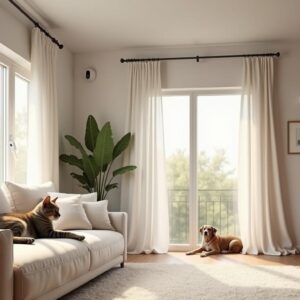Learning about the Best siding material can feel like a big step, but it’s also a chance to protect and enhance your home. There are numerous siding options, each with unique benefits to suit different climates, budgets, and design preferences. Whether you’re looking for something energy-efficient, budget-friendly, or simply a fresh aesthetic, exploring various materials can help you create a long-lasting exterior that complements your house and neighborhood.
Contents
- 1 What different siding options can do for your home
- 2 Types of siding materials and comparisons
- 3 Enhancing energy efficiency and sustainability
- 4 Siding installation tips for a smoother project
- 5 Weather-resistant siding and humid climates
- 6 Siding color trends and curb appeal
- 7 Exploring the value of brand reputation
- 8 Boosting your home exterior design with final touches
What different siding options can do for your home
When you explore siding types, you’ll notice differences in durability, appearance, and overall performance. Some materials require minimal upkeep, while others need periodic maintenance of siding materials to stay in top shape. Choosing wisely can lower long-term expenses and ensure your home remains weather-resistant.
Balancing cost of siding options and longevity
Price often influences how homeowners make decisions. One approach is to weigh the cost per square foot against how long the siding is likely to last. Beyond the initial investment, consider the expenses for repairs or repainting, which can vary. A relatively affordable siding material may need more frequent upkeep. On the other hand, spending more upfront can deliver better durability, ultimately saving you money in the long run.
Finding low-maintenance siding for high comfort
If you want fewer chores and a neat exterior, consider materials that don’t demand extensive work. Options like vinyl or fiber cement often only need a good wash once in a while. Their surfaces resist fading and are built for areas with harsh weather or humid climates. Low-maintenance siding is ideal if you’d rather spend afternoons enjoying your home, not repainting it.
Types of siding materials and comparisons
Siding materials comparison involves factoring in style, installation complexity, budget, and the local climate. Each material offers unique strengths, and some have distinct visual appeals that boost curb appeal.
Vinyl siding and its versatility
Vinyl siding appears in countless shapes, textures, and colors, and you can even find clapboard siding and board and batten siding styles within this category. This adaptability allows you to harmonize with any home exterior design. Vinyl siding reviews often highlight its affordability, which makes it a favorite among homeowners. It’s also relatively easy to maintain. A downside is that very harsh impacts can crack or dent certain panels, so be mindful of potential repairs.
Wood siding pros and cons
Wood siding exudes a classic appeal that many homeowners value. Popular forms of wood include cedar, pine, and redwood. The major advantage is the warm, organic character it provides, which can significantly enhance aesthetics of siding, especially in rustic or traditional designs. However, wood requires significant maintenance, including painting and sealing, to resist pests and moisture. For those seeking the timeless look without heavy upkeep, engineered wood siding can be an alternative worth exploring.
Fiber cement siding benefits you should know
Fiber cement siding is lauded for its strength and longevity. Composed of wood pulp and cement, it’s heavier than vinyl and requires a bit more effort during siding installation. Despite the extra work, fiber cement siding benefits include high resistance to rot, insects, and fire. Painting is needed eventually, but this siding holds its color for a long time. Thanks to its durability, it’s often top-of-mind among best siding brands catering to both new constructions and siding replacement options.
Metal siding advantages
Metal panels, particularly aluminum siding and steel, are known for impressive weather resistance. This quality makes them popular in regions prone to extreme temperatures or storms. Metal siding advantages also include low maintenance, as it resists mold and requires infrequent cleaning. However, denting may occur if struck by heavy objects, so consider the environment around your home. Combining metal with insulation (insulated siding) can help enhance energy efficiency.
Other materials to explore
• Composite siding: Blends wood fibers and resin for a durable, often budget-friendly alternative.
• Brick siding: Timeless appearance with excellent insulation but comes with a higher cost per square foot.
• Stone veneer siding: Captures the appearance of genuine stone at a reduced price and weight.
Each choice brings a different look and maintenance profile, so review siding materials comparison charts where possible. This approach helps you see which meets your requirements for style, resilience, and affordability.
Enhancing energy efficiency and sustainability
Many homeowners want eco-friendly siding options that not only save on utility bills but also reduce environmental impact. Energy-efficient siding like insulated vinyl or fiber cement can maintain comfortable indoor temperatures by reducing heat flow.
Materials for eco-conscious homeowners
Some manufacturers offer siding that incorporates recycled content or uses environmentally responsible production processes. This helps conserve resources while lowering your carbon footprint. Opting for green siding can be especially helpful if you live in areas with extreme heat or cold, where insulation and weather resistance become crucial.
Siding installation tips for a smoother project
Proper installation is key for maximizing performance and durability. Even a premium product can fail if installed incorrectly. Hiring a certified contractor is often the best route, especially if you’re dealing with heavy fiber cement or advanced products from the best siding brands.
Planning and preparation
Begin by inspecting the house exterior for damage, such as rotting sheathing or mold. Address these issues before moving ahead with new siding. Ensure you have accurate measurements to minimize waste and unexpected cost increases. Good planning also involves scheduling the installation during favorable weather. Avoid heavy rain, as it can affect adhesives or sealants, particularly if you’re working with wood siding.
Adhering to local codes and warranties
Different communities have varied regulations, including municipal codes for siding and roofing jobs. Confirm that materials and methods meet local standards. This protects your investment and ensures valid warranties. Reputable installers often provide siding installation tips and advice on securing permits or documentation. Keep your receipts and written warranties for future reference.
Weather-resistant siding and humid climates
In regions that see a lot of moisture, it’s vital to pick siding that resists water damage. Siding for humid climates usually involves vinyl or fiber cement, both of which tolerate excessive dampness. A simple power wash will often free them of mildew or mold.
Facing harsh storms
If your home endures frequent storms, look for durable siding options that withstand high winds and hail. Some engineered products undergo rigorous tests for impact or wind resistance. Studying vinyl siding reviews or fiber cement specifications can confirm whether your chosen material meets local weather challenges.
Siding color trends and curb appeal
Deciding on the right color involves more than personal taste. If you plan to sell your home, color choice can influence buyers’ first impressions. Lighter shades often reflect sunlight, keeping interiors cooler during summer, while darker tones can warm the home in colder months. When browsing siding color trends, think about your roof color, neighboring homes, and any unique architectural features.
Matching exterior elements
Coordinating shutters, doors, and trim with your new siding can create a cohesive look. Darker trim on lighter siding, for example, really pops and frames the house. Stone veneer siding around the base can also add texture. If you’re aiming for a modern aesthetic, metal or composite siding can complement minimalistic landscaping and contemporary windows.
Exploring the value of brand reputation
Well-known manufacturers invest in better technology and quality assurance, so you’re less likely to face surprise defects. A recognized brand can also offer improved warranties. That said, smaller or newer options may provide innovative solutions at competitive prices. Keep in mind that the best siding brands generally have a history of customer satisfaction and consistent performance.
Researching product support
Before committing to any brand, check if they provide guides or customer service. Even high-quality materials may need occasional touch-ups. Accessible support simplifies finding matching paint or trim pieces. Local distribution is also a plus. You don’t want to wait too long for the product to arrive when a shipment is delayed.
Boosting your home exterior design with final touches
Siding for curb appeal includes adding subtle accents around eaves or windows. Small enhancements, like decorative vents or contrasting trim, can unify your home’s look. Reflect on how your siding choices blend with the landscaping. Everything from shrubs to walkways influences the overall feel.
Warranties and long-term savings
A thorough warranty can be invaluable. If your choice of siding has any issues, a strong warranty ensures coverage for repairs. Over time, you’ll appreciate these safeguards, especially if you plan to stay in your home for many years. When combined with careful installation and mindful maintenance, your siding can stay attractive and robust for decades.
Choosing the right material often comes down to your climate, budget, and style preferences. Whether you lean toward vinyl siding for simplicity, wood siding for a warm look, fiber cement siding for resilience, or metal for weather resistance, there’s an option to match your goals. Integrate these elements, keep an eye on local building codes, and work with professional installers if needed. That extra attention up front can reward you with a strong, beautiful exterior that lasts.





